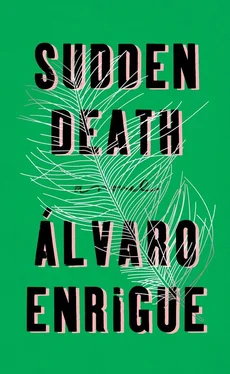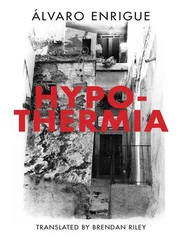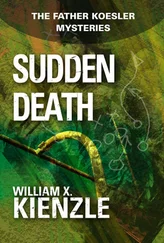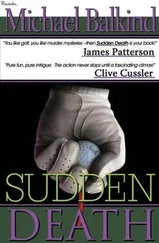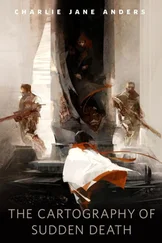When he had no choice but to welcome the recent arrivals to his palace, he waited on them with reluctance and fear. It wasn’t superstition that made him afraid of them, as legend has it. He was terrified because they had arrived at the city gates at the head of a troop of rebellious nations from all over the empire. Never in the two hundred years that the Aztecs reigned supreme in Mexico had anyone put together an army like the one that Cortés mustered from the entire east of the realm. None of the cities loyal to Moctezuma had been able to halt them, and though the survival instincts of Spaniards and Aztecs — the two minority groups in the contest — made it necessary for one side to say that they hadn’t come to conquer anything and for the other side to believe them, everyone knew — regardless of how hard they tried to pretend otherwise — that sooner or later the ground beneath their feet would become a mire watered with the thick broth of slaughter.
Cortés and Moctezuma met at the end of the Tacuba causeway, where the church of Jesús Nazareno stands today, at the intersection of República del Salvador and Pino Suárez. The tlatoani gave the captain a necklace of jade beads and received a pearl necklace in exchange — probably strung by Malitzin. The two of them walked to the royal palace, whose foundations today lie under the Palacio Nacional. The visit, though ominous, wasn’t directly catastrophic: Cortés had presented himself in Tenochtitlan with his Spanish company alone, to avoid the awkwardness of being seen surrounded by sworn enemies of the Aztecs. The emperor was accompanied by the kings of the Triple Alliance, the caciques of all the lakeside estates and their captains, among whom was Cuauhtemoctzin, a cousin of Moctezuma on his wife’s side.
Once they had reached the palace, the full imperial court settled around a courtyard to witness the conversation between Moctezuma and Cortés. It was a conversation in which no one would have understood anything, not only because there could not have been two people in the world more utterly remote from each other, but because what was said in Nahuatl had to be translated first into Chontal and then into Spanish and what was said in Spanish had to be translated first into Chontal and then Nahuatl, since the conquistador didn’t trust any tongue but that of Malitzin, who spoke Chontal and Nahuatl, and that of the priest Jerónimo de Aguilar, who spoke Chontal and Spanish.
They exchanged more gifts and messages of goodwill. When they were done, the emperor returned to his sacred routine, removing himself from view of his guests and subjects — no one would see him again until the day of his death — to concentrate on ruling an empire that by this point had shrunk by nearly half.
Over the next eighteen months this empire, already slim, would grow even slimmer, until it occupied only the Valley of Mexico, and then only Lake Texcoco, and at last only the island city of Tenochtitlan. On August 13, 1521, the empire was nothing but the royal barge, on which Cuauhtémoc was seized trying to escape by water from the wrecked Aztec capital. For once, history was just: a particularly bloody realm reduced to a single barge. Though that didn’t mean the good guys had won. The good guys never win.
Several months after his meeting with the Spanish captain, Moctezuma sent word to Cuauhtemoctzin: now that the Spaniards had recovered from the shock of seeing the biggest and most hectic city in the world, he should take Cortés for a stroll, show him something, anything. Get close to him, the blind eunuch messenger whispered to the emperor’s cousin; listen to him, let him feel that you’re interested in him. Why me, asked Cuauhtémoc. Because you speak Chontal, said the messenger.
The young man had so far been an invincible captain and an intelligent ally of the throne. He was discreet, solitary, trustworthy. Noted for his discipline in a world where discipline was paramount. Tell the emperor I’ll take him to the ball game, he replied.
He waited a few days to approach Malitzin, Cortés’s Chontal tongue; he waited for the end of the first harvest, which was celebrated with games that were anticipated all year and that were definitely a sight for a foreigner to see.

The German historian and cultural critic Heiner Gillmeister believes he has discovered the oldest play-by-play account of tennis as we know it. An ur — ball game that predates everything: Italian calcio , English cricket, what in French is called jeu de paume and in Spanish pelota .
The first recorded tennis match in human history took place in hell and was a doubles match. It was played by four demons, using the soul of a French seminarist by the name of Pierre. In time, Pierre became abbot of the monastery of Marienstatt as Petrus I, and found fame. His story was preserved because Caesarius of Heisterbach recorded it in a volume called Dialogus miraculorum .
As the story tells it, Pierre the Idiot — as the first tennis player of all time seems to have been known in his youth — made a Faustian stumble. He had a terrible memory and was incapable of concentrating on anything, so to pass his exams at seminary he accepted a gift from Satan. It was a stone that contained all the knowledge of man, and all one had to do to possess that knowledge was squeeze it in one’s fist.
Brother Pierre did what any of us might have done in his place, and he got top marks in his exams without having to study. But one day he fell into something that we would now identify as a comatose state — which in his time was simply death. As he told it later, a foursome of demons extracted his soul from his body, feeling free to play tennis with it since the Idiot had unwittingly accepted the deal when he squeezed the stone.
The four demons, like four ordinary friends, made their way back to hell with the object they had borrowed from the world of the living and played a tennis match with their metaphysical ball. Pierre remained conscious and felt the satanic serves and returns in his flesh. According to his testimony, the match was particularly torturous because — as everyone knows — demons have steel fingernails and never trim them.
The fact that the first written account of a tennis game describes an eschatological battle recounted from the perspective of someone called Petrus I, pope of an alternative church of condemned men and killers, a church of ball and racket, is one of the little bones that history occasionally throws us.
In the second part of Don Quixote , Altisidora has a vision, in which she sees devils playing with rackets of fire, using books “full of wind and stuffing” as balls. Unlike Don Quixote , these books are in no condition to survive a second round. After the first volley “there wasn’t one ball that could withstand another or was in any condition to be served again, and so books old and new came in quick succession.”
In hell, souls are balls and bad books are balls. Demons play with them.

It’s said that Caravaggio’s dagger had a Latin inscription carved on both sides of its blade. It read “Nec spe” on one side and “Nec metu” on the other: “Without hope. Without fear.”
Regarding Most Popes’ Utter Lack of a Sense of Humor

Читать дальше
